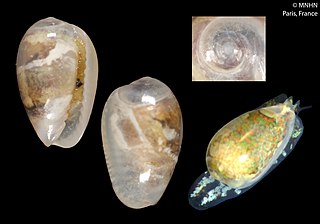
The bee hummingbird, zunzuncito or Helena hummingbird is a species of hummingbird, native to the island of Cuba in the Caribbean. It is the smallest known bird.

The Cuban macaw or Cuban red macaw is an extinct species of macaw native to the main island of Cuba and the nearby Isla de la Juventud. It became extinct in the late 19th century. Its relationship with other macaws in its genus was long uncertain, but it was thought to have been closely related to the scarlet macaw, which has some similarities in appearance. It may also have been closely related, or identical, to the hypothetical Jamaican red macaw. A 2018 DNA study found that it was the sister species of two red and two green species of extant macaws.

The big free-tailed bat is a bat species found in the Americas.

Setosphaeria rostrata is a heat tolerant fungus with an asexual reproductive form (anamorph) known as Exserohilum rostratum. This fungus is a common plant pathogen, causing leaf spots as well as crown rot and root rot in grasses. It is also found in soils and on textiles in subtropical and tropical regions. Exserohilum rostratum is one of the 35 Exserohilum species implicated uncommonly as opportunistic pathogens of humans where it is an etiologic agent of sinusitis, keratitis, skin lesions and an often fatal meningoencephalitis. Infections caused by this species are most often seen in regions with hot climates like Israel, India and the southern USA.
The Caribbean bioregion is a biogeographic region that includes the islands of the Caribbean Sea and nearby Atlantic islands, which share a fauna, flora and mycobiota distinct from surrounding bioregions.

Cystiscidae is a taxonomic family of minute sea snails, marine gastropod mollusks or micromollusks.
Luttrellia is a genus of fungi in the family Halosphaeriaceae. The genus contains four species.

Calophyllum antillanum is an evergreen, medium-sized tropical tree in the Calophyllaceae family. It is also known as Antilles beauty leaf, Antilles calophyllum, Alexandrian laurel, Galba, Santa Maria, mast wood, and West Indian laurel.

The Cuban crocodile is a small-medium species of crocodile endemic to Cuba. Typical length is 2.1–2.3 m (6.9–7.5 ft) and typical weight 70–80 kg (150–180 lb). Large males can reach as much as 3.5 m (11 ft) in length and weigh more than 215 kg (474 lb). Despite its smaller size, it is a highly aggressive animal, and potentially dangerous to humans.
Prunum antillanum is a species of sea snail, a marine gastropod mollusk in the family Marginellidae, the margin snails.

Monocerin is a dihydroisocoumarin and a polyketide metabolite that originates from various fungal species. It has been shown to display antifungal, plant pathogenic, and insecticidal characteristics. Monocerin has been isolated from Dreschlera monoceras, D. ravenelii, Exserohilum turcicum, and Fusarium larvarum.
Ekmanianthe is a genus of flowering plants in the family Bignoniaceae. It is most closely related to Tabebuia and has sometimes been included within it. It consists of two species of trees, neither of which is especially common in any part of its range:

Exserohilum is a genus of fungi in the family Pleosporaceae. The Exserohilum species are known for causing blight and human immune system diseases. The sexual reproductive states of Exserohilum species are known as Setosphaeria. The type species is Exserohilum turcicum. This genus is among three dematiaceous that are categorized for containing pathogens leading to diseases like phaeohyphomycosis.
Exserohilum curvatum is a species of fungus in the family Pleosporaceae. Found in Venezuela, where it grows on the leaves of Sorghum, it was described as new to science in 1984. It differs from other Exserohilum species by its distinctly curved conidia.
Exserohilum echinochloae is a species of fungus in the family Pleosporaceae. Found in Bangladesh, where it grows on the leaves of Echinochloa colona, it was described as new to science in 1984. It is morphologically similar to Exserohilum monoceras and E. frumentacei, but differs from those species in its longer and wider conidia.
Exserohilum inaequale is a species of fungus in the family Pleosporaceae. Found in Nigeria, it was described as new to science in 1984. It differs from other Exserohilum species in the size, shape, and septation of its conidia. Additionally, the septa are comparatively dark and thick.
Exserohilum oryzicola is a species of fungus in the family Pleosporaceae. Found in Colombia, where it grows on the leaves of Oryza sativa, it was described as new to science in 1984. It is distinguished from other Exserohilum species by its longer and more tapered conidia.
Exserohilum oryzinum is a species of fungus in the family Pleosporaceae. Found in Egypt, where it grows on Oryza plants, it was described as new to science in 1984. It is distinguished from other Exserohilum by its distinctly curved to sigmoid (S-shaped) conidia.
Exserohilum heteropogonicola is a species of fungus in the family Pleosporaceae. Found in Uttarakhand, where it grows on the leaves of Heteropogon contortus, it was described as new to science in 1984. It has conidia that are cylindrical to fusoid (spindle-shaped), and often curved.
Exserohilum longirostratum is a species of fungus in the family Pleosporaceae. Found in India, it was described as new to science in 1957 as Helminthosporium longirostratum, and transferred to the genus Exserohilum in 1984.








